How the World’s Freakiest Watchmaker Dreamt Up His Wild New $230,000 Masterpiece

This is an edition of the newsletter Box + Papers, Cam Wolf’s weekly deep dive into the world of watches. Sign up here.
The sound of multiple clocks ticking at once never ceases inside MB&F’s new Beverly Hills boutique—the revered independent maker’s first-ever standalone US shop. Because this is MB&F, of course, those clocks are shaped like cutesy spaceships ripped from Wes Anderson’s imagination. Seated just beyond them, in the back of the airy space, is the brand’s founder Max Büsser—a beloved cult figure in the watch industry. (To wit, a fellow watch obsessive texted me after my meeting: “Hope u had a good time w busser the handsome king.”)
Büsser, dressing in a blue sport coat over a white tee, is tucked into a sharp-angled, U-shaped alcove. The shape is based on the work of midcentury architect John Lautner, who designed some of LA’s most far-out houses. The magic of MB&F is that it’s built on all these obscure and extremely specific references that Büsser organizes his entire brand around. Consider Grendizer, the robot hero of a ‘70s anime series that the watchmaker watched as a child and still loves today. As Büsser tours me around the store, pointing out a photograph of the Hollywood sign with Grendizer superimposed over top, he tells me there’s a reference to the character in every watch he makes. He shows me the crown on his Legacy Machine Perpetual, which is engraved with the shape of Grendizer’s battle axe. On past watches, he’s imitated the shape for the rotor or engraved it on a bridge.
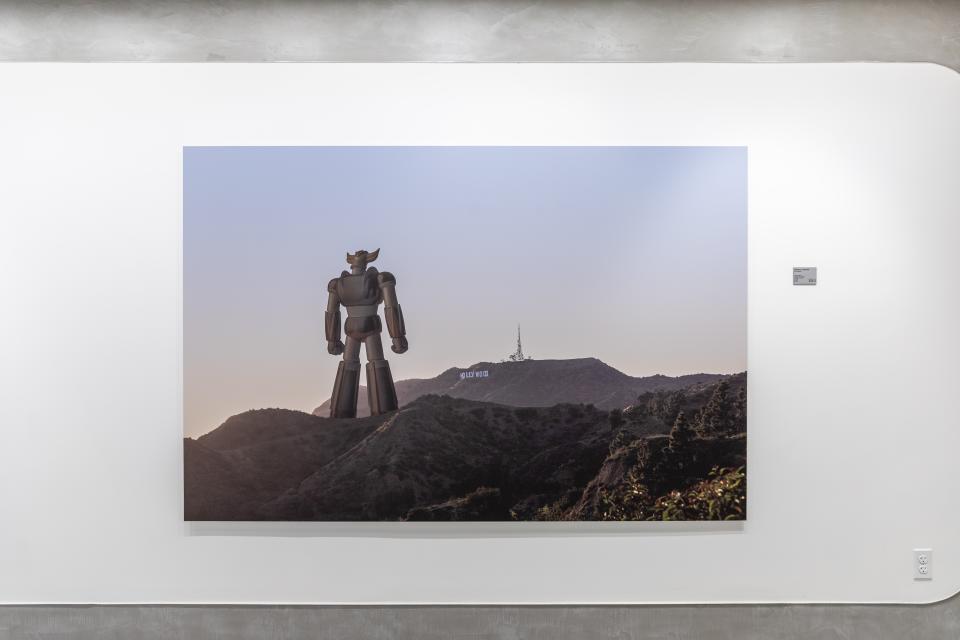
There is a lot of newness swirling around Büsser’s world right now. Before flying out to Los Angeles to open the Beverly Hills store, he was in Dubai to share one of MB&F’s latest “Horlogical Machines”: the HM11, which Büsser has nicknamed “The Architect.” The watch is meant to resemble oddball architecture from the ‘60s and ‘70s, like the Brenton house, and even comes with a temperature indicator. “Because it’s a house!” Büsser explains. Sitting on the couch cushion just a few inches away from Büsser is his phone. It’s blowing up because, on the morning of our meeting, MB&F announced that it was releasing a special “Lucky” edition of one piece that would go to folks who had missed out on all three raffles for the previous iterations of the model. “I don't even want to open that damn thing because I know how many hundreds of messages [there will be from] happy or unhappy people,” Büsser joked.
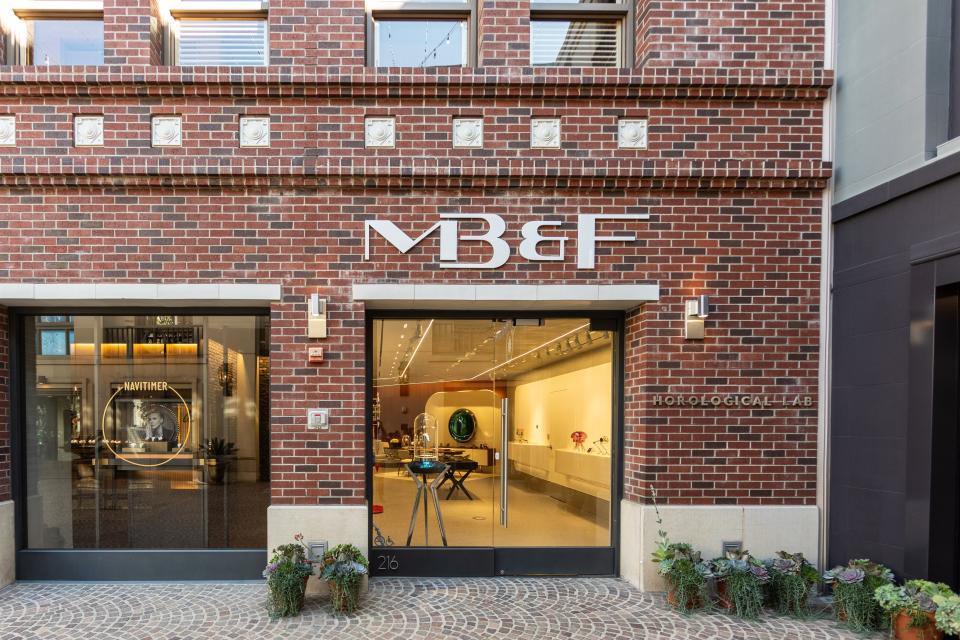
ON THE NEW HM11
The first thing Büsser asks is if I want to try on the new bulbous watch. Obviously I do. What I think is smart about the new MB&F is that it’s actually vaguely watch-shaped. What’s helped the brand catch on over the past few years are its “Legacy Machines”—(slightly) more traditional-looking watches with a zesting of Büsser’s madness. The HM11 shares that quality: it’s circular and the 42 millimeter size doesn’t engulf the wrist. It doesn’t have a twisty bezel but you can rotate the piece, giving it that same satisfying movement.
It’s funny how many of Büsser’s space-age looking inventions actually rely on obsolete technology. Of course, MB&F couldn’t fill its new watch with mercury for the HM11’s temperature gauge. Instead, Büsser found a company in Germany that made thermometers out of metallic strips that expand and retract as the temp changes. The manufacturer agreed to remake them for these watches.
For every order, MB&F will adjust the temperature to track Celcius or Fahrenheit. “There's only one country in the world—just one, I thought there were more—which is not in Celsius,” Büsser says, still a little shocked. (Ding, ding, ding: it’s the US.) But, he says, that quirk will help contribute to some rarity. “If you're an American and you order the watch in Fahrenheit, it will be, let's say, maybe six out of 25 [there will be 50 total, half with a rose gold dial and 25 more in blue]. Those will be history.” All 50 watches, Büsser confirms, have already been claimed. I can already imagine the auction a few years down the line: “AN EXTREMELY RARE EXAMPLE OF A FAHRENHEIT INDICATOR HM11.”
ON MEMES
“I'm probably the only watch owner, creator, CEO, or whatever who actually responds to everybody on social media,” Büsser says with a hint of pride. “I'm going to probably have to stop at some point, because it’s just taking up so much of my bandwidth.” Büsser is something like a folk hero in the watch world and he sees much of the chatter about him—including a meme that compared him to a supermodel.
“They're funny,” he says. “I'm not shredded to pieces. I try to post a response when they make fun of me and be a good sport.”
ON THE JOB THAT CHANGED HIS LIFE
Recently, one of the Opus watches that Büsser designed for Harry Winston in the early 2000s came up for auction. Rather than celebrate the nearly $110,000 result, Büsser got sentimental about the job that he says paved the way for the rest of his career. “Opus changed my life without me realizing,” he says. “Opus allowed me to meet people like Vianney [Halter], like Felix [Baumgartner] and Martin [Frei] from Urwerk. Brand owners who didn't give a damn about money. I met those guys, and they made me dream.
“Meaning, they didn’t create their brands as a business. They created a brand because that's the only thing they love doing—all they knew how to do. It was a way of expressing themselves, and they knew it was going to be rough and brutal. And it was rough and brutal for all of us, [until about] three years ago. I mean, none of us ever expected to see any light at the end of the tunnel. I never lost any money on MB&F but $300,000 in annual profit is probably the highest I've ever done. And my salary has always been less than half of what I used to make at Harry Winston. And I didn't expect it to get better. And suddenly now—boom—we have all these people like, ‘Oh, please, please give me a watch.’ Where were you guys the last 15 years when all of us were going around the world trying to find customers who would pay a bit of attention to us?”
ON REX
Büsser is close friends with Rexhep Rexhepi—known to him simply as “Rex”—who is perhaps the hottest young watchmaker in the industry and a recent Louis Vuitton collaborator. “He [generates] the highest amount of interest out of us,” he says, referring to himself and other independent makers. “People are going with jerry cans of gas in front of his workshop and they douse themselves and they’re with their Zippo like, ‘If you don't give me a watch, I'm gonna set myself on fire.’ He doesn't need LV and he did it, so it's great. When big brands, big groups start paying attention and nurturing independent talent, everybody wins.”
MAX BÜSSER ON HIS FAVORITE ARTWORKS INSIDE THE NEW MB&F STORE
Every MB&F store is filled with what the watchmaker calls “kinetic art.” Rather than paintings that sit idly on the wall, these works flow and come alive as you walk by them. I asked Büsser to tell me about his favorites inside the new Beverly Hills shop. “Everything I have is always something I would like to have at home,” Büsser says. Oh, yeah, and if you have MB&F-level cash, you can walk out with one of these, too. It’s all shoppable.
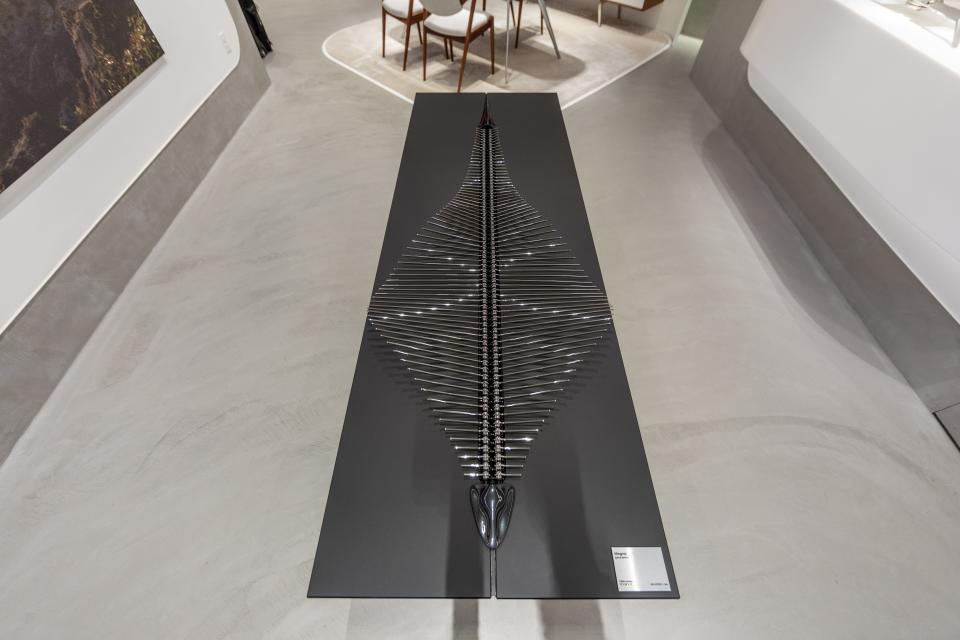
Apical Reform, “Stingray,” $43,000
The spokes jutting out from the center of this sculpture constantly dip up and down to make it look like it’s really floating through the ocean. “It's the first kinetic art piece [Apical Reform founders Amrish Patel and Darshan Soni] ever made,” Büsser says. The studio is currently rethinking the piece’s entire mechanism to make it possible for it to work while hanging vertically on the wall.
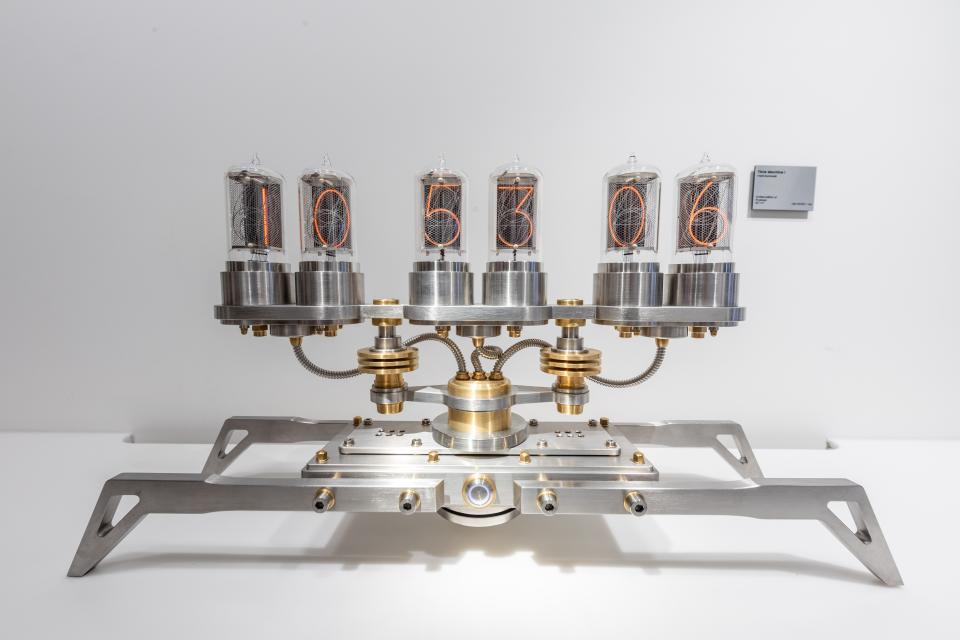
Frank Buchwald, “Time Machine I,” $32,000
I mentioned Büsser’s appreciation for obsolete tech earlier and no piece typifies that more than the “Time Machine I” clock. “I discovered [Buchwald] 13 years ago and I thought his machines were beautiful,” Büsser says. “I wrote to him and said, ‘How can I buy one buy directly from you?’ He said it was $8,000. I was like, ‘$8,000? For a lamp!?’ And he said, ‘Look, I do everything by hand in my own studio. And I do, like, four a year.’”
Büsser persisted. A collector of his was a fan of what are known as Nixie bulbs, a type of filament bulb from the ‘50s and ‘60s. “So I actually went to Frank, who didn't know about it, and he created the first what we call the Nixie machine, and it's basically a clock.” The catch is that no one actually made these bulbs anymore, so Büsser found someone in the Czech Republic to produce them for him and these clocks.
Marc Ninghetto, “Solitude of a Machine, prices vary from $2,200 to $6,700 based on size (see image above)
Swiss photographer Ninghetto creates an image like this for every MB&F store. This one, naturally, finds Grendizer keeping watch over the Hollywood sign. Büsser has one of these hanging at his home in Dubai, too. “I actually have his first series, which were not specific to a city,” he says. “It's [set] in in the Alaskan arctic—photos in the rain and snow.”
Breakfast Studio NYC, “World Sky,” 40,000 Swiss Francs
“In Dubai, we have little kids coming in all the time to see this,” Büsser says. “They are all jumping up and down all day long. I mean, the poor staff.” It doesn’t take me long to understand the appeal to MB&F’s customers-in-training. The artwork is made up of thousands of small discs that flip around at incredibly high speeds to reflect the shape of whatever is standing in front of it. A fitting way to grab a portrait of Büsser, as seen below, wouldn’t you say?

When small children aren’t jumping in front of it, the piece connects to WiFi to display the sky of any place in the world of your choosing. This one, programmed to show the famously cloudless skies of Los Angeles, probably won’t be the most exciting.
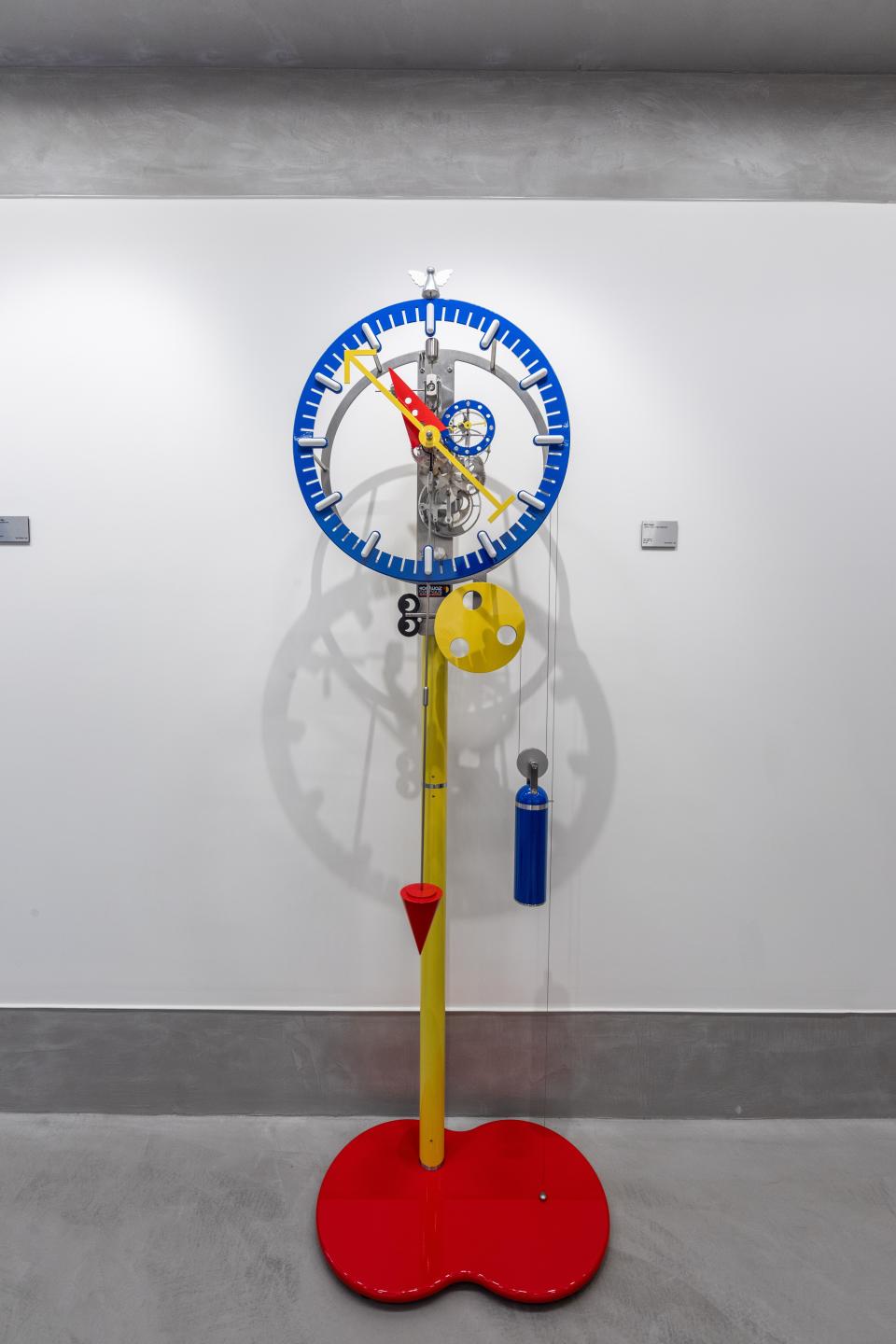
KB2 Lebru X Silberstein, “Tall Clock,” 26,900 Swiss francs
Alain Silberstein is beloved in the watch world for his playful and colorful take on timepieces. Here, his signature squiggly hands are rendered much bigger on a tall standing clock. “This is a 150-year-old clock that has been reinterpreted by Alain,” Büsser explains. “They're so whimsical and so beautiful.”
See all of our newsletters, including Box + Papers, here.
Originally Appeared on GQ

